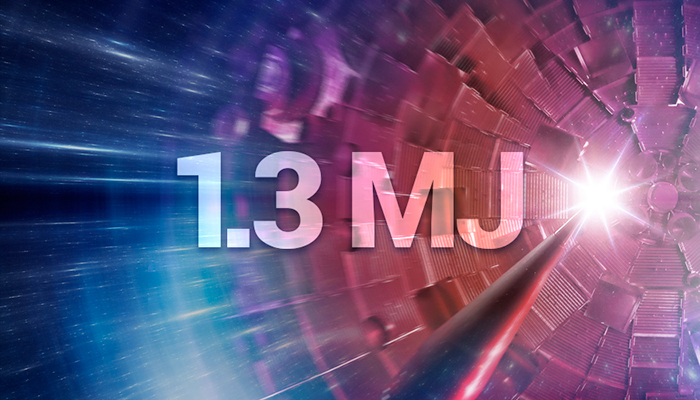NIF Experiment Puts Researchers at Threshold of Fusion Ignition
August 18, 2021
 NIF researchers stood at the threshold of fusion ignition after achieving a yield of more than 1.3 megajoules (MJ), a 25X increase over NIF’s 2018 record yield. Credit: John Jett
NIF researchers stood at the threshold of fusion ignition after achieving a yield of more than 1.3 megajoules (MJ), a 25X increase over NIF’s 2018 record yield. Credit: John Jett An Aug. 8 experiment at NIF made a significant step toward ignition, achieving a yield of more than 1.3 megajoules (MJ). This advancement puts researchers at the threshold of fusion ignition, an important goal of NIF, and opens access to a new experimental regime.
The experiment was enabled by focusing laser light from NIF–the size of three football fields–onto a target the size of a BB that produces a hot-spot the diameter of a human hair, generating more than 10 quadrillion watts of fusion power for 100 trillionths of a second.
“These extraordinary results from NIF advance the science that NNSA depends on to modernize our nuclear weapons and production as well as open new avenues of research,” said Jill Hruby, DOE under secretary for Nuclear Security and NNSA administrator.
The central mission of NIF is to provide experimental insight and data for NNSA’s science-based Stockpile Stewardship Program (SSP). Experiments in pursuit of fusion ignition are an important part of this effort. They provide data in an important experimental regime that is extremely difficult to access, furthering our understanding of the fundamental processes of fusion ignition and burn, and enhancing our simulation tools to support stockpile stewardship. Fusion ignition is also an important gateway to enable access to high fusion yields in the future.
“This result is a historic step forward for inertial confinement fusion (ICF) research, opening a fundamentally new regime for exploration and the advancement of our critical national security missions,” said LLNL Director Kim Budil. “It is also a testament to the innovation, ingenuity, commitment, and grit of this team and the many researchers in this field over the decades who have steadfastly pursued this goal.
“For me it demonstrates one of the most important roles of the national labs–our relentless commitment to tackling the biggest and most important scientific grand challenges and finding solutions where others might see only the obstacles,” Budil said.
While a full scientific interpretation of these results will occur through the peer-reviewed journal/conference process, initial analysis shows an 8X improvement over experiments conducted in spring 2021 and a 25X increase over NIF’s 2018 record yield.
“Gaining experimental access to thermonuclear burn in the laboratory is the culmination of decades of scientific and technological work stretching across nearly 50 years,” said Los Alamos National Laboratory Director Thomas Mason. “This enables experiments that will check theory and simulation in the high energy density regime more rigorously than ever possible before and will enable fundamental achievements in applied science and engineering.”
The experiment built on several advances gained from insights developed over the last several years by the NIF team including new diagnostics; target fabrication improvements in the hohlraum, capsule shell, and fill tube; improved laser precision; and design changes to increase the energy coupled to the implosion and the compression of the implosion.
“This significant advance,” said Mark Herrmann, LLNL’s deputy program director for Fundamental Weapons Physics, “was only made possible by the sustained support, dedication, and hard work of a very large team over many decades, including those who have supported the effort at LLNL, industry and academic partners, and our collaborators at Los Alamos National Laboratory and Sandia National Laboratories, the University of Rochester’s Laboratory for Laser Energetics, and General Atomics. This result builds on the work and successes of the entire team, including the people who pursued inertial confinement fusion from the earliest days of our Laboratory. They should also share in the excitement of this success.”
Looking ahead, access to this new experimental regime will inspire new avenues for research and provide the opportunity to benchmark modeling used to understand the proximity to ignition. Plans for repeat experiments are well underway, although it will take several months for them to be executed.
More Information:
“Laser Fusion Experiment Unleashes an Energetic Burst of Optimism,” The New York Times, August 17, 2021
“A National Lab Just Achieved a ‘Wright Brothers Moment’ in Nuclear Fusion,” CNBC, August 17, 2021
“US Lab Stands on Threshold of Key Nuclear Fusion Goal,” BBC, August 18, 2021
“With Explosive New Result, Laser-Powered Fusion Effort Nears ‘Ignition,’ ” Science, August 18, 2021
“Fusion Supports the Stockpile,” NIF & Photon Science News, July 28, 2021
“New Machine-Learning Tactic Sharpens NIF Shot Predictions,” NIF & Photon Science News, July 8, 2021
“10-Year Report Highlights NIF’s Contributions to Plasma Science,” NIF & Photon Science News, July 8, 2020
“Nuclear Diagnostics Help Pave the Way to Ignition on NIF,” NIF & Photon Science News, March 6, 2020
“NIF Experiments Close In on Burning Plasma,” NIF & Photon Science News, May 8, 2019
—Breanna Bishop
Follow us on Twitter: @lasers_llnl



